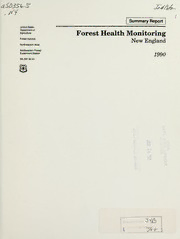
Forest health monitoring New England, 1990 : summary report PDF
Preview Forest health monitoring New England, 1990 : summary report
Historic, Archive Document Do not assume content reflects current scientific knowledge, policies, or practices. 7 Summary Report UnitedStates Departmentof Forest Health Monitoring Agriculture ForestService New England NortheasternArea Northeastern Forest ExperimentStation IddO NE-INF-94-91 ro CO > -< n== 1 Acknowledgments Forest Health Monitoringis truly a cooperative effort. Besides the numerous individuals thatformed the Area and Station partnership, many other individuals ofnumerous agencies worked to make the program a success. The U.S. Environmental Protection Agency provided portable data recorders and technical supportfor the equipment. The State Foresters from Maine, New Hampshire, Vermont, Massachusetts, Connecticut, and Rhode Island gave their critical support to the program and provided the services of their staffs to help develop the program and collect thefield data. Forestry Canada helped with critical decisions and theirAcid Rain National Early Warning System (ARNEWS) was one model we studied in the design of Forest Health Monitoring. Without the support and participation ofall, it is unlikely that ForestHealth Monitoring in 1990 would have been the success it proved to be. Summary Report , 8^ Forest Health Monitoring New England Robert xjErooks, (^.S. DepartmentofAgriculture, Forest Service, Amherst, Massachusetts^ Margare^^Miller-Weeks, U.S. Department ofAgriculture, Forest Service, Durham, New Hampshire WilliamjBurkman, U.S. Department ofAgriculture, Forest Service, Radnor, Pennsylvania Northeastern Area Association ofState Foresters and USDA, Forest Service Northeastern Area Northeastern Forest Experiment Station in cooperation with U.S. Environmental Protection Agency Forestry Canada May 1991 NE-INF-94-91 1990 Summary Report Forest Health Monitoring New England New England The six-state New Engleind region is estimated to be over 80 percent Forest Resource forested. With a total land area ofmore than 40 million acres, forestland comprises over 32 miUion acres. The predominance of forestland occurs throughout New England, with Maine most extensively forested (89 percent) and forestland in southern New England exceeding 60 percent oftotal land area. Over 85 percent ofNew England forests are classified as one offour major forest-tj^ groups: White Pine, Spruce-Fir, Oak-Hickory, and Northern Hardwoods. Across New England, 76 tree species have been recorded on forest survey plots. The most common conifers are balsam fir and red spruce and the most common hardwood species is red maple. The New England forest is maturing, with 46 percent presently classified as sawtimber-sized stands (trees generally larger than 10 or 11 inches in diameter) and presumably containing the oldest trees. The area ofsawtimber-sized stands increased 36 percent fi-om the surveys ofthe 1970's. Concurrently, smaller poletimber-sized stands (trees 5 to 10 or 11 inches in diameter) and seedling-saphng-sized stands (trees less than 5 inches in diameter) decreased, respectively, 8 and 51 percent in area. The forests ofNew England have been, and continue to be, exposed to abroad range ofstressors, both natural and human-caused. Natural stressors include weather extremes, forestinsects, and pathogens. Human-caused stressors include land-use change, air pollution (for example, ozone), and acidic deposition. A new but imsubstantiated concern is global climate change due to generation ofgases that create a "greenhouse effect." The predominance offorests in New England, their importance for recreation, water, £ind wood products, and the increased awareness of stress upon forest ecosystems have resulted in a demand to address concerns about forest "health" and human influences. Forest Health The pubHc's concern for the "health and productivity offorests in Monitoring: certain regions ofthe United States" resulted in federal legislation New England mandating "such surveys as are necessary to monitor long-term trends in the health and productivity ofdomestic forest ecosystems" (PubHc Law 100-521). This mandate was implemented in the six New England states in 1990 with the cooperative efforts ofthe U.S. Department ofAgriculture Forest Service (USDA Forest Service), U.S. Environmental Protection Agency (USEPA), and the six New England state foresters. Subsequent legislation (Public Law 101-624) encouraged the USDA Forest Service to work in partnership with state foresters or equivalent state officials to "monitor forest health." 1 ForestHealth Monitoring(FHM) is intended to be a long term efifort with a major emphasis to detect imexpected changes fix)m established FHM baseline forest conditions. Specific objectives of are to: 1) characterize forestconditions, 2) characterize the major potential forest stressors, 3) quantify changes in forest conditions, and 4) analyze the relationships between changes in forest conditions and potential forest stressors. Forest conditions will be described by the measurement and reporting ofdata fi*om several "health"indicators. Five indicator groups have been selected: growth, foliar S3rmptoms, soil chemistry, foUar chemistry, and landscape characterization. Individual measurements may support one or more indicators. Measurements will be made and indicators characterized on a periodic basis; annually for those that change frequently (for example, foliar symptoms) and on a 4 year or greater cycle for those that change less fi-equently (for example, soil chemistry). FHM is based on the annual remeasurement ofan extensive network ofpermanent locations, selected to correspond to a systematic sampling grid developedby the USEPAfor their Environmental Monitoring and Assessment Program. In New England, this sampling design )delds 263 s£imple locations on all lands, forest and nonforest. Each location consists ofa cluster offoiu* plots. All trees, including seedlings and saphngs, are located, marked, and measured. On, or FHM adjacent to the location, openings in the forest are searched for indicator plant species known tobe sensitive to ozone, sulfur dioxide, and hydrogen fluoride. At each location, data are collected on the geographic and topographic position and physiographic description of the location; tree species, diameter, crown position, crown condition, and damage; othervegetation; and foliar sjmiptoms on indicator plants. Data quahty standards are specified in the field data collection manual and explained during field crew training. These standards were monitored by the remeasiu*ement ofa subset of locations and trees. 1990 Results Sample Distribution The 263 FHM locations in New England represent the forest resource as reported by the most recent forest surveys. The distribution ofthe forested plots does not differ significantly from that expected of previous forest surveys for land use, forest-type group, or stand-size class. 2
